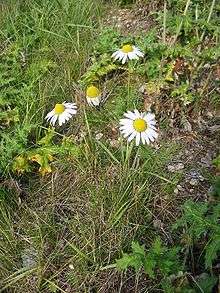Tripleurospermum inodorum
| Tripleurospermum inodorum | |
|---|---|
 | |
 | |
| Scientific classification | |
| Kingdom: | Plantae |
| (unranked): | Angiosperms |
| (unranked): | Eudicots |
| (unranked): | Asterids |
| Order: | Asterales |
| Family: | Asteraceae |
| Tribe: | Anthemideae |
| Genus: | Tripleurospermum |
| Species: | T. inodorum |
| Binomial name | |
| Tripleurospermum inodorum (L.) Sch.Bip. | |
| Synonyms | |
| |
Tripleurospermum inodorum, common names scentless false mayweed,[1] scentless mayweed, scentless chamomile, wild chamomile, mayweed, false chamomile, and Baldr's brow, is the type species of Tripleurospermum. This plant is native to Eurasia and North Africa and is considered an invasive weed in North America.
Historically included the genus Matricaria, Tripleurospermum inodorum has been the subject of some controversy, with many revisions in recent years. The Flora Europaea uses Matricaria perforata for this species. Synonyms/other scientific names include Tripleurospermum perforatum (Mérat) Lainz, Tripleurospermum maritimum subsp. inodorum.
Ecology
Pollen is collected by solitary bees.[2]
Mythology
In Sweden and Norway, it is called Baldr's brow, but in Iceland, it is the close relative Sea Mayweed (Matricaria maritima) that carries this name.[3] In Gylfaginning, Snorri Sturluson explains that the name Balder's brow comes from the plants' whiteness:
|
|
References and footnotes
- ↑ "Tripleurospermum perforatum". Natural Resources Conservation Service PLANTS Database. USDA. Retrieved 15 December 2015.
- ↑ Wood, Thomas J.; Holland, John M.; Goulson, Dave (2016). "Providing foraging resources for solitary bees on farmland: current schemes for pollinators benefit a limited suite of species". Journal of Applied Ecology. doi:10.1111/1365-2664.12718.
- ↑ Den virtuella floran (in Swedish)
- ↑ An online edition of the Old Norse text.
- ↑ Brodeur's translation in English.
External links
![]() Media related to Tripleurospermum inodorum at Wikimedia Commons
Media related to Tripleurospermum inodorum at Wikimedia Commons